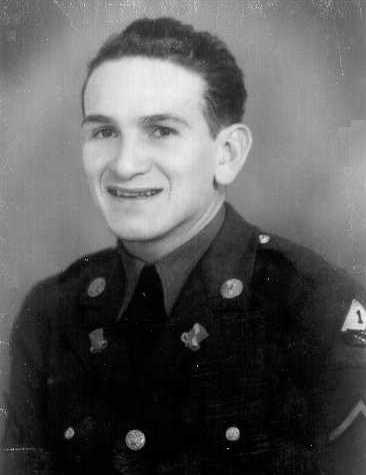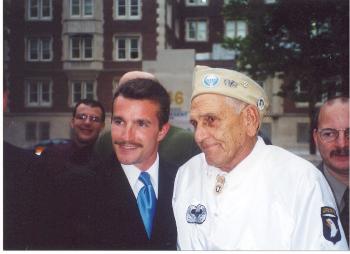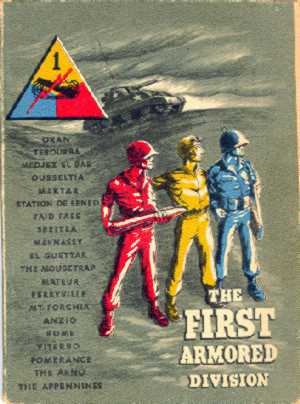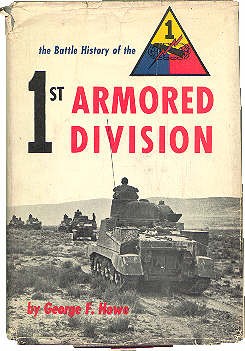 |
| MENU SELECTION: | The Italian Campaign | At The Front | Books | Armies | Maps | 85th Division | GI Biographies | Websites |
 |
PFC Henry
J. Guarnere
47th
Armored Medical Battalion
1st
'Old Ironsides' Armored Division
Brother of Sgt.
Bill Guarnere,
Co E, 506th
PIR, 101st Airborne Division
"BAND
OF BROTHERS"
PFC Henry Guarnere was killed in action on 6th January, 1944 while serving with the 47th Medical Battalion. Private Guarnere is one of the many casualties of the war that is just another nameless person in the battle statistics. Recently, his death became well known by the TV mini-series "BAND OF BROTHERS". PFC Henry Guarnere was the brother of Sgt. William "Wild Bill" Guarnere, Company E, 506th Parachute Regiment, 101st Airborne Division. The mini-series was about Company E and their personal experiences during the war. The first episode depicts how Bill accidentally discovered that his brother was killed at Cassino.
From the first time I saw that episode, I was curious to find out about Henry and his service and his death. Here is the story of Henry Guarnere that I have been able to put together.Henry Guarnere’s home was in Pennsylvania where he enjoyed baseball as a kid. He was a nut about the sport and collected newspaper articles and cards on all the teams. He was a quiet kid but kept a watchful eye over his brother, Bill.
When the war began, he tried to enlist in the Marines but was turned down. Then he was drafted into the Army. Bill also tried to enlist into the Marines, but he too was turned down. Bill eventually volunteered for the paratroopers and went to Camp Toccoa, Geogia.
Henry became a medic in the 47th Armored Medical Battalion. Henry was a natural medical corpsman, as he was always practiced fixing and healing at home. The 47th Armored Medical Battalion was a support unit of the 1st Armored Division. Here is a brief description of this division.
The 1st Armored Division entered combat in the North African Campaign. The armored infantry battalions were part of the Allied landings at Oran on 8 November, 1942, where they suffered heavy casualties against the French Morrocans. Gradually the Americans gained confidence and marched across Morroco to fight the Germans in Tunisia. Tech 5 Henry Guarnere earned a Silver Star Medal for risking his life to render medical aid to a wound soldier.
Silver Star Commendation for
Tech 5 Henry Guarnere
HENRY GUARNERE, (ASN 33026746), Technician Fifth Grade, Medical Detachment, * * * * * * * Battalion. For gallantry in action on * * * 1943 in the vicinity of * * * * *, Tunisia. During heavy counter battery fire a solider in a gun section was seriously wounded and unable to reach shelter. Technician Fifth Grade Guarnere voluntarily and without hesitation ran to the wounded soldier and began administering first aid to him. Although the position was still receiving heavy fire he completely disregarded his own welfare by remaining with the wounded soldier until he completed his first aid treatment. His daring and heroic actions undoubtly save the soldier's life. The gallantry, perseverance, and concern for the welfare of a wounded comrade displayed by Technician Fifth Grade Guarnere reflect great credit upon himself and the command and are highly commendable.
Entered Military Service from hiladelphia, Pennsylavania. (Medal No. 24737)
General Order No. 44, 1st Armored Div., Dated 7 May 1943
For security reasons, it was common practise to conceal the Place and/or the date on the Orders using *****.
Origins of the 1st Armored Division & 47th Armored Medical Battalion
The 47th Forward Support Battalion was constituted 7 January 1939 in the regular Army as the 4th Medical Squadron and activated 1 February 1939 at Fort Knox, Kentucky. The battalion went through further change on 1 January 1942 when it was re-designated as the 47th Armored Medical Battalion.
The 1st Armored Division trained in the US and departed the US in May 1942 on the Queen Mary. The unit stopped in Ireland for re-equipping with new equipment and further training. In November 1942, they were deployed to North Africa. After the Germans surrendered in North Africa, the 1st Armored rested during the 2-month campaign in Sicily and then was deployed to the Italian mainland.
The 1st Armored Division arrived in mainland Italy in mid-November 1943, just north of Naples. It was used to exploit a possible breakthrough in the Liri River valley leading from Cassino to Rome. The first objective was Monte Porchia and a series of small hills between Monte Lungo and the Rapido River.
To force its way into the Liri Valley, II Corps had first to clear the route along Highway No.6 by taking Mts. Porchia and Trocchio, south of the highway, and another group of hills and high ridges on the other side. The ist Armored Division was to provide the elements of a force to defend Mt. Lungo until the attack be-gan, and then to assault Mt. Porchia. On its southern flank, British 10 Corps was at the same time to seize Cedro Hill, a satellite of Mt. Porchia, while on the northern flank, the 34th Division was to advance from San Pietro to San Vittore and La Chiaia, nearest the highway, and against Cervaro. On the extreme northern flank of II Corps, the First Special Service Force and reinforcements were scheduled to take the heights around Mt. Majo.
See description of Battle of Monte Porchia, below.
The 1st Armored Division fought in Italy as part of General Mark Clark's 5th Army during the remainder of the war. The 1st Armored Division was the only US armored division in Italy. However other mechanized units included US tank destroyers, 6th British Armoured Division and 6th South African Armoured Division. On occasion, the mountains and deep mud rendered the armored units useless at times. But the armored units were combined with infantry to form fast-moving mechanized units during rapid advances around Rome and in the Po Valley.
Now, we pick up the story of Henry as told from the viewpoint of his brother, Bill, in the book by Stephen Ambrose and the TV-series called, "BAND OF BROTHERS".Sgt. Bill Guarnere completed training with the 101st Airborne Division. They were shipped over to England for further training and awaiting the invasion. At the end of the first TV episode, the 506th Parachute Regiment prepares to board the aircraft when the June 5 invasion is canceled. The paratroopers go back to base to relax and watch movies. By mistake, Bill puts on the wrong jacket and in the pocket he finds a letter to one his buddy's from his girl back home. He reads it and finds out that his brother was killed in action at “Cassino”.
This was shocking news to Bill just before his jump into combat. He turns and comments to his friend; "Where in the Hell is Cassino?" In the next episode, we follow Bill as the paratroopers jump into Normandy in the early hours of June 6, 1944. Bill takes out his revenge on his brother’s death when his company ambushes some Germans in his first combat during the pre-dawn hours. Later that day, Company E took out a German artillery battery, which earned Bill and 7 other of his comarades the Silver Star.
PFC Henry Guarnere was killed in action about 6 month before Bill discovered news of his death. Henry was buried at the American Cemetery in Nettuno, Italy, with the other casualties of the Cassino/Anzio campaign.
Bill Guarnere's airborne unit continued to fight in Normandy and in Holland. Then in December 1944, the 101st Airborne Division was sent to defend Bastogne against the surprise German attack. Almost 1 year to the day after Henry was killed in action, Bill Guarnere was wounded on 3rd January at Bastogne. He lost his leg from shrapnel during a German artillery barrage on their dugouts but he survived the war.Based on the date of Henry’s death, I researched the battles that the 1st Armored Division participated in during January of 1944. The Battle of Monte Porchia was the only battle that was of any significance at this time that coincides with this date. So, it is assumed that Henry Guarnere was killed while performing the duties of a medical orderly at this battle.
The 1st Armored Division had transferred from North Africa after a rest during the battle for Sicily and Salerno. It arrived in Italy in mid-November 1943. Its first major combat in Itlay would be Monte Porchia. Monte Porchia was relatively small compared to the mountains typical of central Italy. Its importance was derived from its isolated position commanding the low ground lying between the Monte Maggiore-Camino hill mass to the south and Monte Trocchio to the northwest. Highway No. 6 cut across the lower northern slopes, extending to the north across the River Rapido at Cassino.
References :
Here are a few references that describe the Battle of Monte Porchia and the 1st Armored Division."Salerno to Cassino", US Army History Series, Mediterranean Theater of Operations, by Martin Blumenson
"Fifth Army At the Winter Line", US Army Series, CMH Pub 100-9
"The Battle History of the 1st Armored Division" by George Howe, 1954
"The 1st Armored Division" a 64-page booklet printed during war and issued to the soldiers. Go to The 1st Armored Division
For a history of this battle, I quote from a chapter of Howe's book. This text mentions the work of the medics and the chaplains who gave aid and comfort to the wounded, which I have underscored.
The map of Monte Porchia is from CMH Pub 100-9.Click to skip the History & continue with Stories.
Battle of Monte Porchia - January 1944
The preparations took several days, extending beyond New Year's Day. The opposing armies greeted 1944 by simultaneous artillery "serenades" on prearranged targets. Daylight brought with it a blizzard. The Liri Valley, already soggy, promised for a time to be a hopeless place for the maneuver of heavy, armored vehicles--like the Medjerda River valley in Tunisia had been a year or so earlier. Plans were therefore rushed for a large amphibious operation behind the enemy's lines which might force him to weaken his defenses along the Garigliano-Rapido rivers. While these plans were still incomplete, the drive through the last barriers of the Winter Line began.II Corps (General Keyes) designated a special Task Force Allen for the attack on Mt. Porchia instead of giving the job to the Division command. The force was to combine the 6th Armored Infantry (Col. Paul Steele) with the tanks of two separate armored battalions which were not a part of the Division--the 753d and the 760th--but was to include Division Artillery and the 701st Tank Destroyer Battalion. The 1108th Engineer Combat Group (48th and 235th Battalions) were to give engineer support. Brig. Gen. Frank Allen, Jr., of Combat Command B, 1st Armored Division, was to command this force in his first operation against the Germans since coming to the Division at Rabat during the summer. II Corps insisted on this arrangement in spite of General Harmon's objections that the force should make the attack under Division control. The situation was reminiscent of that in the autumn of 1942, when Combat Command B under General Oliver rather than the Division had been selected by II Corps for the assault at Oran.
Allen's plan of attack sent two battalions of the 6th Armored Infantry attacking abreast, the 1st Battalion with elements of the 753d Tank Battalion on the north astride Highway No.6, and the 2d Battalion, supported by tanks from the 760th Tank Battalion, on the south astride the railroad line. To reach the line of departure for the assault on the hill, the force had to cross more than two miles of open flat, cut by tributaries of the Garigliano. This ground was mined, and well surveyed by enemy artillery. Two low knobs on the northern flank in the path of the 1st Battalion gave the enemy high ground from which heavy machine guns could sweep the valley floor with enfilading fire.
Battle for Mount Porchia - Shows the attack of the three battalions of the 6th Armored Infantry Regiment. The German defenders included 134th Grenadiers and elements of the Herman Goring Division. {From US Army Series, "Fifth Army At the Winter Line"}
Allen recognized the necessity of crossing this area under cover of darkness. Although artillery and air attacks on specific targets were to be provided during the two previous days, no special preparation was scheduled for just before the attack, in the hope of achieving surprise. The line of departure was partly under the enemy's control and unlikely to be reached without a fight.
The two assault battalions came down from higher ground and started out across the flat at 1930, 4 January 1944. Ahead of them with mine detectors were men from Company A, 16th Armored Engineer Battalion, who had been parceled out among the infantry companies. Deffenbaugh's 1st Battalion quickly met heavy resistance, and took a long time to reach a phase line while under flanking fire from the two low knobs. Ringsak's 2d Battalion therefore waited at the first phase line for the other battalion to advance abreast of it. There it was struck by an overwhelming volume of deadly accurate artillery and mortar fire.The troops soon dropped back, leaving scores of casualties on the field. Medics and stretcher bearers were taxed to the utmost by the large numbers to be evacuated. Chaplain Arthur C. Lenaghan repeatedly went out with them until he was fatally wounded. Others ministered to the dying where they fell, or to the wounded at the aid stations. Additional aid stations were set up, one of them in a barn where General Harmon had been briefly resting, after seeing his men begin the attack. Chaplain William J. O'Brien came over from the 1st Tank Group to the 6th Armored Infantry to take Father Lenaghan's place, and during the next two days while the battle continued, organized parties of Italian civilians who helped the soldiers bring out the dead and take them to a cemetery. { Underscore emphasizes the role of the medics in this battle.}
The enemy counterattacked on the morning of 5 January with infantry and tanks but American artillery drove him back. By 1515, after an artillery preparation, Task Force Allen resumed its approach to Mt. Porchia. The depleted 2d Battalion had gone into reserve. The 1st Battalion shifted southward and took up the at-tack along the railroad, while the 3d Battalion left the nose of Mt. Lungo to attack along Highway No.6. The enemy there had been worn down and all but isolated, but the 3d Battalion still had a slow time of it under heavy artillery fire. They got as far as the north-south road from Taverna, on the highway, to Rocca d'Evandro, on the railroad. From that line of departure, the assault on Mt. Porchia finally started at 0700, 6 January.
Forward Observers on Mount Porchia after it was occupied by the Allies.
From this position, they could observe the Rappido and Liri valleys.
The enemy had been awaiting an attack for weeks, and gave this one a hot reception. He had put out many mines, including the new Schu mine now first encountered by the attacking force. His pillboxes had withstood the artillery bombardment. The stone houses near Mt. Porchia were used as machine-gun nests. German artillery and mortar fire was heavy. Tanks of the 760th Tank Battalion, leading the deliberate advance, blasted the houses and pill-boxes and were aided by elements of the 235th Engineer Combat Battalion. Early in the afternoon, 2 officers and 20 enlisted men of Companies A and B, 6th Armored Infantry, reported that they were on the crest at the north end of Mt. Porchia. They sent back almost as many German prisoners taken there. But the enemy sent in reinforcements from reserve positions west of Cassino; three companies of the Hermann Goering Division counterattacked at dusk and recaptured the top of Mt. Porchia. At 1800, the 48th Engineer Combat Battalion dropped work along the railroad and entered the fight as infantry, one company to each battalion of the 6th Armored Infantry. The 1st Battalion in turn drove the enemy off the crest during the night, reporting at 0300 to Colonel Steele that they held it again. {The other German defenders were elements of the 134th Grenadier Regiment.}
The other two battalions mopped up the lower slopes of Mt. Porchia during the morning of 7 January, and dug in along the ridge with the 1st Battalion. The enemy kept them under artillery fire. At nightfall, they awaited the enemy's next and, as it turned out, his last, counterattack on Mt. Porchia. It began at 0100, 8 January, and was a failure.
After four more days, Colonel Steele withdrew the regiment upon its relief by the 141st Infantry {36th "Texas" Division}. The regiment bivouacked near Bellona on 13 January. Casualties reported then, with later adjustments, were very high. The 6th Armored Infantry had lost 7 officers and 106 enlisted men killed, or died of wounds, 328 wounded and evacuated (including Colonel Ringsak of the 2d Battalion), and 71 missing in action. Losses in other units brought the totals to 139 killed or died of wounds and 402 wounded by 10 January. Several hundred replacements came to the regiment during the battle. They had pitched in as ammunition and ration carriers, and were assigned to the companies to restore their total strength.
Above was quoted from "The Battle History of the 1st Armored Division" by George Howe, 1954.
PFC Henry Guarnere was buried at the American Cemetery in Nettuno, Italy, with the other casualties of the Cassino/Anzio campaign.
The 6th Armored Infantry Regiment of the 1st Armored Division earned the Presidential Unit Citation for its participation at Monte Porchia and a Campaign Streamer - NAPLES-FOGGIA.
Note: I have no specific evidence that PFC Henry Guarnere participated in this combat. But the 47th Armored Medical Battalion was assigned to the 1st Armored Division and was probably called into support this effort. I could not find any records of any of the other units of the 1st Armored Division being involved in combat during the dates of January 4 - 12.
Awards:
PFC Henry Guarnere was awarded the following medals: Silver Star and Purple Heart. His citation for the Silver Star is shown above. The Purple Heart may have been earned while in combat in North Africa or may have been awarded posthumously for his fatal wound January 1944. Also, note that his rank varies and is listed as Private, Private First Class and Tech 5 in the different references. The final rank that was used on his headstone was Private.
Private Guarnere's medals: Silver Star & Purple Heart
On the right is the DUI pin for the 47th Armored Medical Battalion.
The compilation of the material contain on this page is the property of www.custermen.com. Any use of this matierial without prior written consent is not authorized.

Actor Frank John Hughes
poses next to 'Wild
Bill' Guarnere,
whom he portrayed in "BAND
OF BROTHERS".
{Photo used with
permission
from www.wildbillguarnere.com.}
Go to The 1st Armored Division for more detail history of the 1st Armored Division in the Italian Campaign. This 64-page booklet is a brief history given to soldiers at
the end of the war.
"The Battle History of the 1st Armored Division" is a history written by George Howe. |
 |
 |
Go to www.wildbillguarnere.com for photos, news, and forums about "BAND OF BROTHERS".
Go to Photos from Italy top menu.
Return to CusterMen top menu.